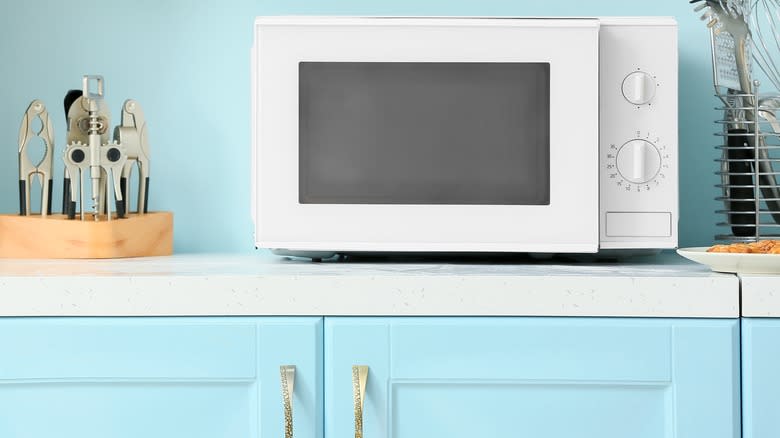The Clever Microwave Tip You Need To Cook Food Evenly Every Time

Microwaving food is such a simple task that it's easy to assume there isn't any science or strategy to it. If you're microwaving your dinner instead of heating it on a stove, it usually means you're preparing it the quick and easy way. But even if you're just warming up leftovers, if you find that your dinner's edges are hot while the middle is still ice cold, you might not be reheating your dish evenly. Consider leaving your food on the edge of the microwave plate instead of the center.
There is a hard science as to why this works, but the short version is that microwaves use microwave radiation to vibrate water molecules in the food, and these vibrating molecules expel heat, which spreads across the food. But often, especially in older models, the microwave field is weaker in certain parts of the oven, which means your microwave will have hotter and colder spots. Often, this colder spot is in the middle, although it varies by microwave. Pushing your food to the carousel's edge gives it a better chance of finding these hot spots and being hit by more radiation. This helps it heat more evenly.
Read more: The Best Kitchen Gadgets You Can Buy
The Science Of Microwave Ovens

With microwaves, it helps to visualize lots of heat waves bouncing off the interior walls while the food reheats until they strike the food and excite the water molecules inside. The little oven comes with a spinning carousel to ensure the food is constantly moving and is exposed to as much radiation as possible. This way, the microwave is less likely to miss a spot. Food in the center is moving less than food at the edges, which means food closer to the edge is receiving more radiation and getting hotter as a result.
You microwaved food can reheat unevenly in other ways, too. Things like salting your food before microwaving can make the heat distribution more uneven because salt absorbs energy and essentially hoards all that microwave heat. Covering your food helps because this prevents steam from escaping, and that steam can help cook your food. Covering the food also prevents any splattering while it's cooking.
More Microwaving Tips

Because microwaves use water molecules to heat food, it can cause that water to evaporate faster and make your food too dry. If your leftovers have grown too chewy after a spin in the microwave, you can help stop them from drying out in the microwave by placing a glass of water next to the food. Once everything's cooking, the glass of water will add more steam into the oven and keep food moistened. Just make sure the glass is microwave-safe.
Lastly, it's a good idea to check on the food occasionally and stir it. No matter how much the food is moving on the edge of the spinning microwave plate, food that's buried deep in the container will likely receive less heat than food on top. By stirring, you're shifting the food around so that different chunks of rice or noodles or meat are now on top and basking in that microwave radiation that'll get it nice and hot.
Read the original article on Daily Meal.

